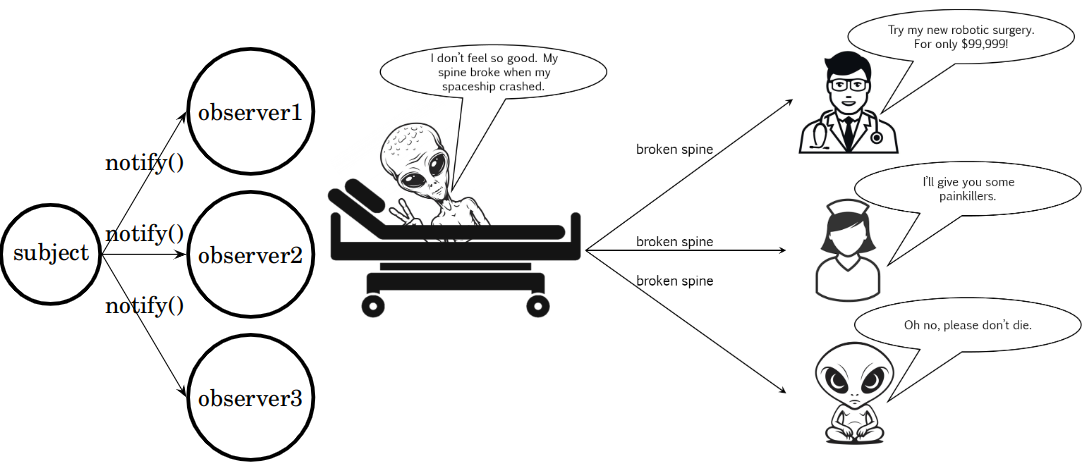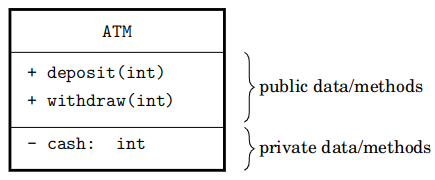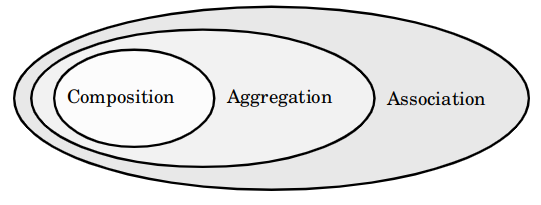Implementing the observer design pattern in C++ in a stock market simulation
1. Introduction
What’s a design pattern?
A design pattern is a tried and true solution to a common problem. Particularly, they provide standard OOP solutions to common problems while making components of the system reusable.
Classes of design patterns
Design patterns all achieve different goals but there exist three broad classes of them. Creational patterns deal with object creation mechanisms, structural patterns ease the design by identifying a simple way to realise relationships between entities and behavioural patterns are concerned withn communication between objects. Observer belongs to the behavioural class.
What problem does the observer solve?
The aim of the observer pattern is to propagate state changes of the object to be observed (subject) into multiple observer objects. It does this by calling each update method of its observers.
For example in a program to monitor stocks where the subject stores a list of stock prices. Implementing the graph view and the tabular view inside the subject itself would make it cluttered and hard to maintain. It’s better to assign the responsibility of observing the price to some UI and tabular view classes and whenever the price changes they’re updated.
More formally, we say that the observer pattern defines a one-to-many relationship so that when an object changes all its dependents are notified automatically when the state of the subject changes.

A concise way to describe the observer is via its UML diagram so before we get into it here’s a little refresher on UML.
2. UML basics
UML blocks
Objects (instances of classes) in UML are visually described by blocks. Their public data and methods
preceeded by + and their private ones by -. For example, the ATM class has the deposit(int amount),
withdraw(int amount) as public methods and cash as private data.

UML arrows
UML connects instances by arrows and each arrow has its own meaning.
| Arrow | Definition | C++ example |
 |
Inheritance: B inherits from A, i.e. it inherits its public/private methods and data including their implementation. B is free to overwrite their implementation. |
|
 |
(Weak) aggregation B is associated with A but B's lifetime does not necessarily depend on A's -- if B is destroyed, A may still live. Summary: B has but shares an object A. |
|
 |
Strong aggregation aka composition. B fully contains A. Composition occurs when a class contains another one as part and lifetime of contained object (A) is tightly bound to the lifetime of the container (B). Summary: B has and owns an object A. |
|
 |
Realisation B realises A. In this case, A is an interface; all its methods are defined but does not implemented. A's methods are called abstract. B inherits from it and implements its methods |
|
 |
Association Class B has a connection to class A. Association is a broad term to represent the "has-a" relationship between two classes. It means that an object of one class somehow communicates to an object of another. Summary: B has an object A. |
|
For example, the relationship of a shirt having a pocket is composition since a pocket only exists in a shirt but the relationship of a car having a wheel is aggregation as a wheel can be removed and used by another car. Composition is a subset of aggregation, which in turn is a subset of association.

3. Observer pattern components
Let’s define the classes this pattern uses:
ISubject– the abstract subject (aka subject interface). Defines the abstract attach, detach and notify methods. It also declares a list of abstract observers.Subject– The object of interest whose internal state changes we want to observe. It operates on the list of observers via its attach, detach, or notify methods. It’s also able to modify and return the state.IObserver– the observer interface. Defines the abstract _update method.ConcreteObserverA,ConcreteObserverB, etc. These subclasses ofIObserverinherit from it and implement the update method. It’s also convenient for them to store a reference toSubjectin order to query its data if necessary.
Strictly speaking, ISubject it maintains a list of IObservers and concreted observers, which inherit from IObserver are appended to it via the attach method. Due to polymorphism the list can accommodate all subclasses of it. Hence IObserver is downcast to the class of the concrete observer.

4. Stock market simulation code
A practical example that demonstrates the observer design pattern is a model of the stock market at the bottom of this article.
StockMarket subject calls UpdateState() to update its ticker (fancy word for stock symbol) pairs
modelled by the state variable pairs_. The latter stores the price for each stock marker symbol in a
dictionary, e.g. {{GOOG: 152.99}, {NVDA: 461.72}} . UpdateState() furthermore
calls NotifyObservers(), which in turns goes through all observers and for each pair in pairs_ it
calls Update(std::string ticker, double price). ticker is the first field of each pair and price its
second. Investor is a dummy concrete observer but Bot keeps a history of each pair in its internal
variables, e.g. GOOG: [148, 152, 149] hence can perform a simulation of an analysis.
The table below shows how the definitions from the observer UML diagram map to the stock market code.
| Diagram | Code | Diagram | Code |
|---|---|---|---|
Subject |
StockMarket |
attach |
AttachObserver |
detach |
DetachObserver |
update(state) |
Update(std::string, int) |
state_ |
pairs_ |
modifyState |
UpdatePrices |
getState() |
pairs() |
ConcreteObserver |
Bot, Investor |
#include <iostream>
#include <iomanip>
#include <vector>
#include <deque>
#include <ctime>
#include <cstdlib>
#include <algorithm>
#include <unordered_map>
#include <cmath>
#include <memory>
// forward declaration of subject as it's required by a concrete observer
class StockMarket;
// observer interface
class IObserver {
public:
virtual void Update(const std::string& stockSymbol, double price) = 0;
virtual ~IObserver() = default;
};
// Concrete observer A
class Bot: public IObserver {
public:
Bot(StockMarket& stock_market);
void Update(const std::string& stockSymbol, double price) override;
void Predict(const std::string& ticker);
private:
StockMarket& stock_market_;
std::unordered_map<std::string, std::deque<double>> price_history_;
unsigned hist_length_;
};
// subject interface
class ISubject {
public:
virtual void AttachObserver(std::shared_ptr<IObserver> investor) = 0;
virtual void DetachObserver(std::shared_ptr<IObserver> investor) = 0;
virtual void NotifyObservers() = 0;
virtual ~ISubject() = default;
protected:
std::vector<std::shared_ptr<IObserver>> observers_;
};
// Concrete subject
class StockMarket : public ISubject {
public:
StockMarket() = delete;
StockMarket(std::unordered_map<std::string, double> prices) : pairs_(prices) {}
void AttachObserver(std::shared_ptr<IObserver> observer) override {
observers_.push_back(observer);
}
void DetachObserver(std::shared_ptr<IObserver> observer) override {
auto it = std::find(observers_.begin(), observers_.end(), observer);
if (it != observers_.end())
observers_.erase(it);
}
void NotifyObservers() override {
for (auto observer : observers_) {
for (const auto& pair: pairs_) {
observer->Update(pair.first, pair.second);
}
}
}
// Simulate a change in the state variable and notify observers
void UpdatePrices() {
for (auto& pair: pairs_) {
auto price = pair.second;
pair.second += 0.03*price * (rand()%100 - 40)/100;
}
NotifyObservers(); // Notify all registered observers
}
std::unordered_map<std::string, double> pairs() const {
return pairs_;
}
private:
// state variable of subject - observers are interested in it
std::unordered_map<std::string, double> pairs_;
};
// Concrete observer B
class Investor: public IObserver {
public:
Investor(const std::string& name, StockMarket& stock_market) :
name_(name),
stock_market_(stock_market) {}
void Update(const std::string& stockSymbol, double price) override {
std::cout << "\tInvestor " << name_ << " received update: "
<< stockSymbol << " price is " << std::fixed
<< std::setprecision(1) << price << std::endl;
}
private:
std::string name_;
StockMarket& stock_market_;
};
// Concrete observer B
Bot::Bot(StockMarket& stock_market) :
stock_market_(stock_market),
hist_length_(7) {
for (auto& pair: stock_market_.pairs()) {
const auto symbol = pair.first;
const auto price = pair.second;
std::deque<double> price_copies;
// push N copies of the current price to each ticker to initialise it
for (int i = 0; i < hist_length_; ++i)
price_copies.push_back(price);
price_history_[symbol] = price_copies;
}
};
void Bot::Update(const std::string& ticker, double price) {
std::cout << "\tBot received an update of " << price << " on " <<
ticker << " ticker" << std::endl;
auto it = price_history_.find(ticker);
if (it != price_history_.end()) {
it->second.pop_front();
it->second.push_back(price);
}
}
// predict next price, estimate a technical indicator, suggest buy/sell/hold
void Bot::Predict(const std::string& ticker) {
std::cout << "\tBot says: " << ticker << "'s tomorrow price will be ";
auto it = price_history_.find(ticker);
if (it != price_history_.end()) {
const auto prices = it->second;
// "predict" it as the moving average with some
// positively biased randomness
double prediction = 0.0;
for (auto p: prices)
prediction += p;
prediction /= prices.size();
prediction += rand() % 20 - 5;
// model the RSI by my arbitrary definition
std::cout << std::fixed << std::setprecision(2)
<< prediction << " with RSI = ";
auto it = std::max_element(prices.begin(), prices.end());
double max = *it;
it = std::min_element(prices.begin(), prices.end());
double min = *it;
double curr = prices[prices.size() - 1];
int rsi_perc = static_cast<int>(std::round((curr - min)/(max - min + 0.0001) * 100));
// simulate an analysis (buy/hold/sell)
std::string suggestion = "HOLD";
if (rsi_perc > 70)
suggestion = "SELL";
else if (rsi_perc < 30)
suggestion = "BUY";
std::cout << rsi_perc << " --> " << suggestion << std::endl;
}
}
int main() {
// Create an instance of the subject (stock market)
std::unordered_map<std::string, double> trading_pairs =
{{"GOOG", 150}, {"NVDA", 470}, {"AAPL", 180}};
auto stock_market = StockMarket(trading_pairs);
// Create instances of observers (investors/bots)
auto investor = std::make_shared<Investor>("Alice", stock_market);
auto bot = std::make_shared<Bot>(stock_market);
// Attach observers to the subject
stock_market.AttachObserver(investor);
stock_market.AttachObserver(bot);
// Simulate changes in stock prices
srand(static_cast<unsigned>(time(nullptr)));
constexpr int ndays = 20;
for (int i = 0; i < ndays; ++i) {
// wait for some samples to collect some more meaningful data
if (i > 5) {
std::cout << "-------- day " << i << " --------" << std::endl;
stock_market.UpdatePrices();
for (auto& pair: stock_market.pairs())
bot->Predict(pair.first);
}
}
// Detach all observers
stock_market.DetachObserver(investor);
stock_market.DetachObserver(bot);
return 0;
}
In the end, the two observers report their updates and the bot additionally makes its super sophisticated and advanced analysis.
-------- day 15 --------
Investor Alice received update: AAPL price is 183.4
Investor Alice received update: NVDA price is 477.4
Investor Alice received update: GOOG price is 154.3
Bot received an update of 183.4 on AAPL ticker
Bot received an update of 477.4 on NVDA ticker
Bot received an update of 154.3 on GOOG ticker
Bot says: AAPL's tomorrow price will be 189.28 with RSI = 72 --> SELL
Bot says: NVDA's tomorrow price will be 476.77 with RSI = 68 --> HOLD
Bot says: GOOG's tomorrow price will be 163.90 with RSI = 24 --> BUY